#jikus art
Text

Jiku crisis?!

#radiohead#digital art#artists on tumblr#jonny greenwood#procreate#radiohead fanart#sketches#hatsune miku#jiku???#sorry melinda…#my art
96 notes
·
View notes
Text

Colored the poor pathetic little meow meow, I drew it while humming the song from the Bloom animation meme on YouTube.
I like how this turned out coloring is hard without my laptop
3 notes
·
View notes
Text
Just tired. Trying to nail the hand, the second slipper flew over the edge of the table :7
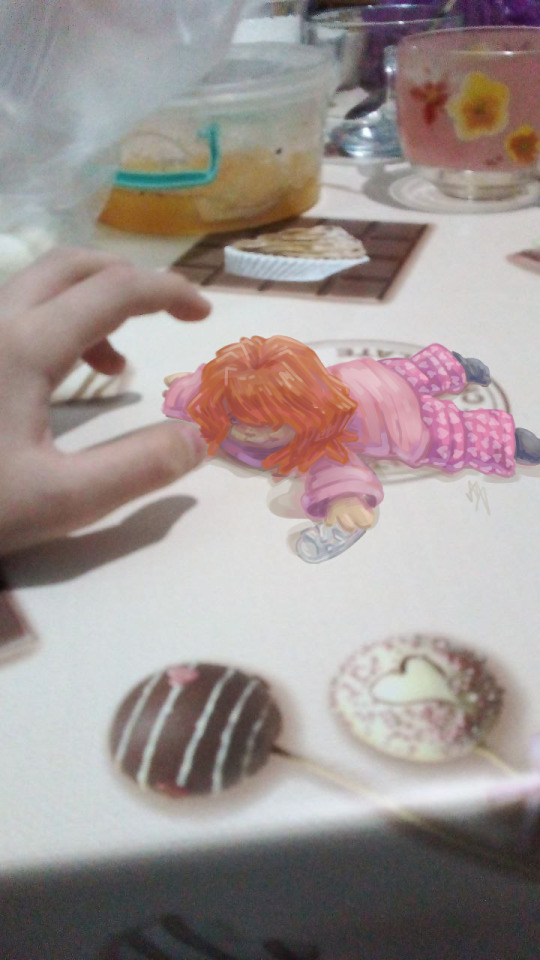

1 note
·
View note
Text
‼️Warning: RANT ABOUT KATSUO’S ART ON 10TH ANNIVERSARIES‼️
If you don’t want to read, please ignore
——-
This is a bit unusual but I still want to express my anger about the kimono version, the Katsuo’s art, on Tsukiuta’s 10th anniversary.

Everything was fine when this picture was posted, up until they released the full body's one

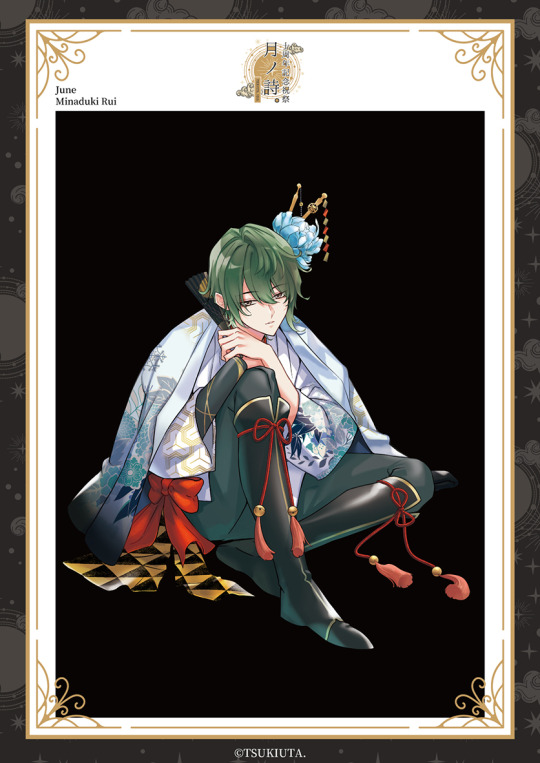
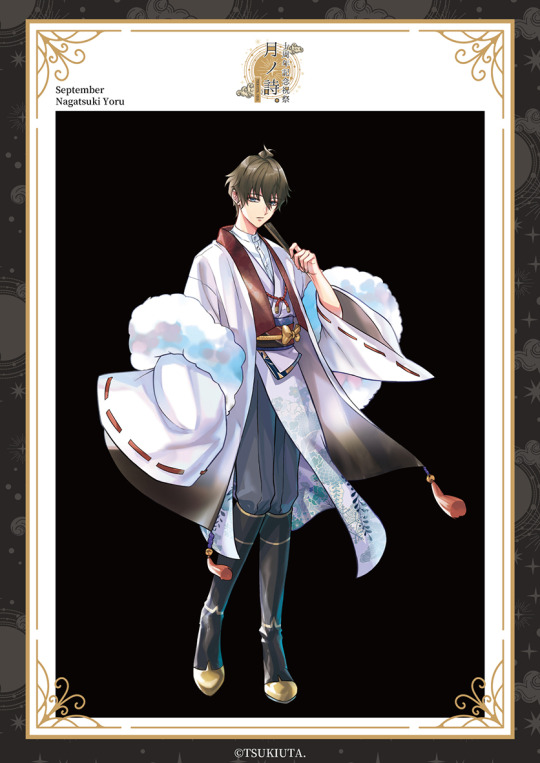
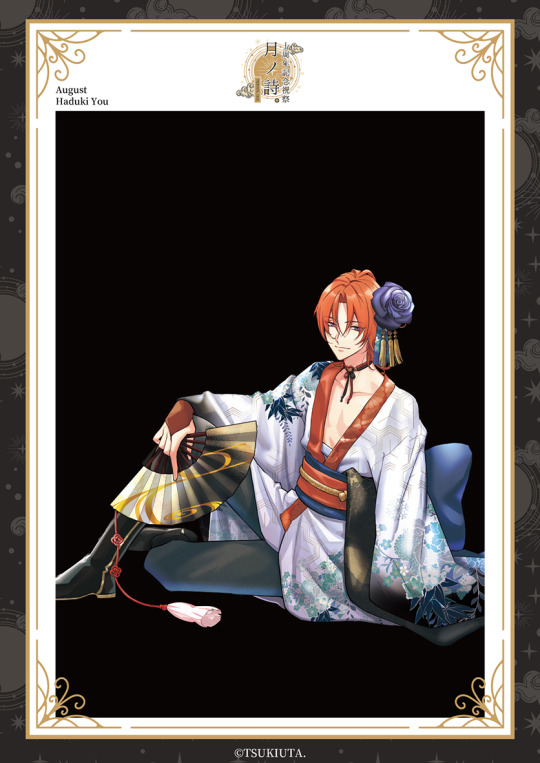
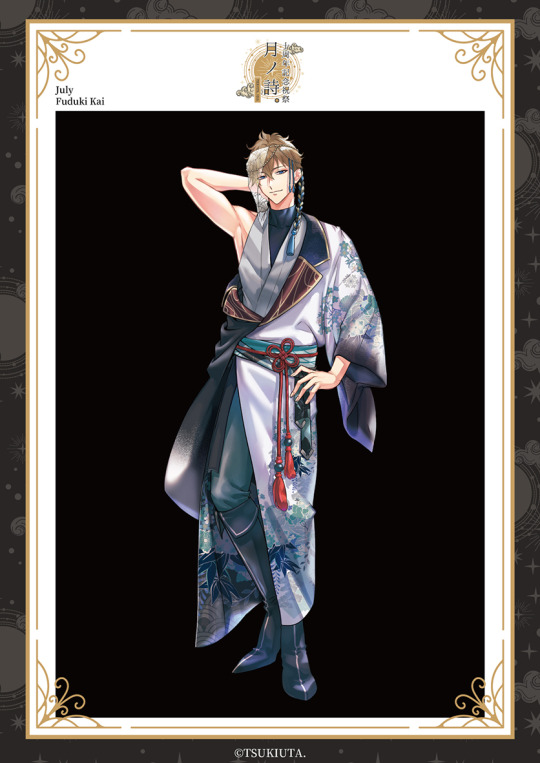

I keep my mouth shut most of the time, but not this time. I will try my best in conveing my thoughs through this post.
First of all, the colors! For the design, I can still ignore it but Procellarum is white, pristine white jade, glowing white. Why is the members' sleeves now are black?!
What is this?! Blacked? Contamineted?
Why Gravi can go all black but Procellarum can't have that??
Amd if you think If only white just like I said, it will be monotonous. Then no, I don't against the combination of difference colors, what I want to say is the way you used it.
Just look at the Shirotsuki art by Jiku (2016), still have many colors but not bad, but look very luxurious
(The birth of this art concept is more beautiful than the 10th anniversary Art 🤡)
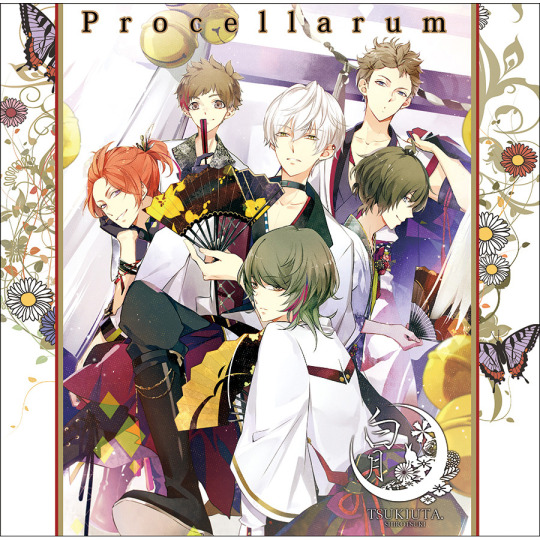
Second, where was Princess Shiroda?!
Why was only Kuroda showed up? Oh yeah, and Krokke too!!
Wheres was Shiroda?! Are you discriminate against the princess? !!
Everyone knows that Gravi's mascot is the black rabbit Kuroda, and Pralella's mascot is white rabbit Shiroda. This doesn't has any different saying Procellarum does not have "presence" at the 10th anniversary 🤡
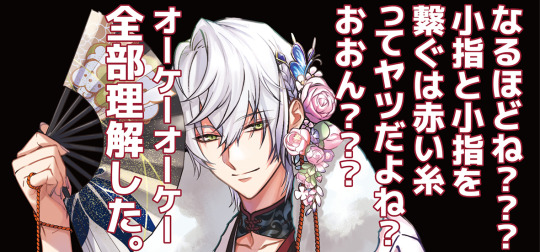
Celebrating the 10th anniversary, it's about fans' feelings for Tsukiuta. The red string on Shun's hand is the his fan for him. Now, you guys let him take it out as a joke that the red string is connected with Hajime?
And why there are only Hajime and Shun have the red string? Where are the others? Are you trying to tell me that the fans of others ten characters are not need to be greatful?
Really, I don't know how the Fandum situation in Japan or the international fans. But with the experiences of being a long time fan of the project, I was really disappointed about this art of the kimono version and TPRO's behavior. If the company keep an eyes on, this would not have happened.
0 notes
Photo


Jasper post!
Jasper post!
JASPER POST!
This is my baby bean. Her name is Jasper and she originally started out as such an asshole but now she’s kinda sad, sweet, and still smol. She is a red timberwolf faunus!
She’s also pregnant with twins! <3
Yay DnD lore!
Draw her if you want and tag me! <3
1 note
·
View note
Text
decided to draw 1/6 evil bastards in my evil bastard team (ues) for the first time in a while. ill do the rest later. this guy is really fucked up

that's jiku shuu. he is simultaneously dr. frankenstein and the monster. he wears a hospital gown instead of a normal shirt under formal wear as a statement. he does not have a surgery license ANYMORE. he uses kids toothpaste because he hates mint. hes killed many people and just considers their deaths "mistakes" in his career. he cant look at himself in a mirror without screaming. he is actually bald
4 notes
·
View notes
Text
Drawing the girls again!

16 notes
·
View notes
Photo




Happy June everyone! I wanted to re-try my hand at fake screenshots and the 90′s anime look with Princess Mill from Maze!
Most 90′s anime had a tenuous grasp on gender vs sex vs sexuality vs presentation, which is why I made both versions here for Mill.
#pride month#lgbtq#maze the mega burst space#90s anime#maze bakunetsu jiku#my art#this is a trans rights blog terfs please get fucked#did you guess i did the full art#then the 90s effect edits#and then decided i couldn't sit by with the funky face and fixed that eye?#cause thats what happened
7 notes
·
View notes
Photo

Jiku-shin Enma, from Yo-kai Watch. The god of space and time. Drawn in pencil. My lighting could have been better, but it was indoors and with a lamp.
#yo kai watch#yokai watch#jiku shin enma#yokaiwatch#youkai watch#artists on tumblr#drawing#fox art#fox fanart
9 notes
·
View notes
Text
Wakasa Imaushi: See You Next Year
Just wrote this to indulge in one of the best romantic memory I got in my life, some years ago it happened and I'm writing it cause someone remembered this for me, let me know what you think about it.
Characther: Wakasa Imaushi, Shinichiro Sano, Keizo Arashi, Takeomi Akashi
Warnings: College AU!, Consume of Alcohol, Pure Fluff.

The 30 december is your meeting, gettin to see again your friends gathered around every corner of the world with their studies or job. The sparkling air predict snow if it wasn't for the impossibility of your location: Tokyo Bay.
You, Benkei, Waka builted a friendship during your first year of college, thanks for your interest to music and martial arts, nothing else was shared in between you, but this strong friendship endure even today after you move abroad to pursue higher education, that's why on Christmas holiday everyone comes back to celebrate Benkei birthday, it's a tradition after all, brought up by his friend Shinichiro Sano a true leader inside this various company.
It's half past two when you leave the pub you used to stay when you lived in Tokyo "I got a job, the pay sucks but I'm doing what I always dreamt of" Benkei says looking down, rummagin in a shop bag, "That's why I finally got the fine rum I always talked about" he says with a grin and plastic glass, "To the man of the day, congrats aren't enough that’s why we cheers to the best future you can ask for! TO BENKEI!" Shinichiro shouts despite being in a residential district, "To the best future!" Waka says looking directly at you while raising glass, "To the future" you repeat turning you glare and avoiding eye contact with the liliac eyes. Blush dust your cheeks and Shin embracing your shoulders says "Come to my house, we will have fun!" and that’s how you find yourself at 6 in morning still dark outside with Benkei and Takeomi completely asleep on Shinichiro’s couch, "I probably should go back home" you say while taking your winter coat preparing yourself to go to the bus stop, "Coming with you y/n" Wakasa says with his bored expression, "Then you're in good hands y/n, come back safe" Shinichiro says while smiling to the both of you.
Your head above looking to the sky "You know I love these nights" you say while walking still staring to the starry sky, "And why is that y/n?" Wakasa says with his grin while adjusting his scarf and taking your hand to keep his warm, "Waka?" you say turning to him with your smile, "I miss you sometimes" "You have my number, and my messy little flat 500 km from your city can always welcome you" he says nonchanantly while tightening the grip, "You know Tokyo is covered in smog. Seeing the stars is something per se, really rarely. It means that the sea wind brought off the dusty clouds and sooner or later is going to snow" you smile finally looking at him who looks at the sky just like you did some minutes before. Until you feel it again, his predatory eyes looking to yours again making you blush, feeling a loud heartbeat which waits for something, and it arrives. A kiss to your lips is what you feel, until he nears to you and put his body near yours, to warm and deepen the kiss, the tongues dancing around his and your mouth, everything around spin and the cold wall he put you on seems invisible now cause the only thing your body feels, is that Wakasa got you. Separating, you look towards him and find him again staring at sky with the same bored expression that distinguish Imaushi Wakasa than everyone else, "Waka why? I mean the kiss" you say curious to know your old crush, "I felt that you needed this" and taking your hand walking to the seaside you arrive saying goodbye, wandering what this meant and what will change, and nothing is what you get as answer as you look to him from the bus, waving your hand and saying goodbye, see you next year Waka.
@httptamaki @presidentmonica @ravenina14 @eriskaitto @ebiharachan @strawberrysanzu @10-jiku
#tokyo revengers#wakasa imaushi#wakasa x reader#tok rev wakasa#wakasa fluff#tokyo revengers x reader#tok rev x reader#tokyo revengers fluff#tok rev fluff#shinichiro sano#shinichiro x reader#benkei#akashi takeomi#tok rev benkei#tok rev takeomi#tok rev shinichiro#black dragon
93 notes
·
View notes
Photo

An interesting state of Hashiguchi Goyo, Onsen-jiku (or yado)
1920
Museum of Fine Arts Houston
142 notes
·
View notes
Photo


Holy shit that improvement tho August 15, 2015 - September 9, 2017 @spacefacedboy
2 notes
·
View notes
Text
Brat cat and anxiety wolf share a smoke

I found a great pose in a gay manhwa I was reading and thought it suited my OC Jiku, only after 40 minutes of sketching did I remember his boyfriend Bard, my friend's OC, is taller than him. Took me ages to redo the pose.
It took many hours to complete because I drew the eyes over and over and over. I hope I still like it tomorrow
2 notes
·
View notes
Text
Junnosuke Miyamoto and the Evil Line of Music Production
What’s the role of a producer? The answer to this question might depend on the field we’re approaching or the scope of the work itself, but for the purpose of anime analysis, as in most forms of artistic media, we could broadly say a producer is the person in charge of making the connections and agreements required to keep a project ongoing. At first glance, the job of producer might not seem like the most interesting or creative role in artistic production, but I have a counterargument in the form of a name: Junnosuke Miyamoto. Never heard of him? Let’s see what the deal is with this man.
The cute Miyamoto
Junnosuke Miyamoto’s longtime relationship with anime production started in 2007, when he was working as an employee for the now defunct Starchild. Starchild was a sub label of the music firm King Records, one of the biggest in Japan. It was specifically made to produce anime and its soundtracks, contemplating both scores and associated music (such as OPs, EDs, insert songs, and even promotional or image songs). Though merely starting as an assistant producer, Miyamoto quickly rose in importance within Starchild, becoming one of the head producers until 2014, year in which he became head of the newly founded Evil Line Records sub label, another subdivision of King Records that we’ll address later.
During that time, Miyamoto cultivated a sort of authorship or artistic character, as the work he produced shared certain characteristics and differentiated itself from most of the anime music of those years. The truth is, Junnosuke Miyamoto brought total weirdos to the anime sphere, artists who nobody would’ve thought to pair with that market, and formed partnerships that not only brought a breath of fresh air to the scene, but matched perfectly the kind of works Starchild was producing. It was an era of experimentation within the anime industry, and anime music was getting a bit behind. Miyamoto broke that comfort zone.
We might start reviewing what was the first anime Miyamoto worked on. Sayonara Zetsubou Sensei, in which Miyamoto was assistant producer, is one of the first (of many) Shaft masterpieces, and the first example of the prolific relationship Miyamoto would have with the studio, followed by almost every collaboration between Starchild and Shaft until their partnership was dropped (we don’t know the details, but perhaps it was due to the success of Madoka and Monogatari Series, both produced by Sony’s Aniplex).
Zetsubou Sensei is relevant to Miyamoto’s career for a number of reasons. Namely, it was one of the first contacts made in anime between artists that would later become staples of Starchild and even Miyamoto’s own Evil Line. The first OP of the series, Hito Toshite Jiku ga Bureteiru, is easily one of the most memorable OPs in anime history to this date, both in its intriguing visuals directed by Shaft’s Tatsuya Oishi and the crazy song that accompanied them. Sung by an unexpected combination, the unit was composed by the already legendary rock and metal singer Kenji Ohtsuki, best known by his classic band Kinniku Shoujo Tai or King-Show, but also famous on his own; in addition to the female seiyuu of the series.
Bure bure bure bure
But this mixture of moe vocals and metal vocals wasn’t casual, as it had a precedent in one of the players at hand. Narasaki, composer and arranger of the song, was already known in the alternative music scene through his band Coaltar of the Deepers, which mixed shoegaze, metal, punk, electronic, and pop influences, often alternating between harsh and soft vocals. They were backed by Tokusatsu, a band formed by Ohtsuki (in vocals) and Narasaki (in guitar), as well as Arimatsu as drummer and King-Show’s Satoshi Mishiba as keyboardist. Tokusatsu would later become part of the Evil Line Records repertoire, and while this is outside the anime sphere, Miyamoto also produced the film Nuigulumar Z, based on a novel written by Ohtsuki and musicalized by Tokusatsu. And the title might also be related to a fixation with the letter Z in Miyamoto that we’ll discuss later.
Miyamoto would continue to work as an assistant producer in the 2nd season of Zetsubou Sensei, and, finally, in 2009, he was assigned main production roles for the 3rd season of the series. Both featured Kenji Ohtsuki and the Zetsubou girls with the Tokusatsu backing band as well, with the theme of the last season being Ringo Mogire Beam, a now classic OP. He repeated his role as a producer in 2011 for Katte ni Kaizou, another Shaft adaptation of Koji Kumeta, the author of Zetsubou Sensei. The OP, surprising nobody, was done by Tokusatsu, but this time it also featured the legendary anison singer Ichiro Mizuki, also known as Aniki (big bro). Mizuki sang many classic anime and tokusatsu OPs, including the original Mazinger Z theme. In that way, Miyamoto brought the nerdy spirits of Tokusatsu, Mizuki, Kumeta, and Shaft together. The OP animation, just like anything from Kumeta, is full of references to anime and tokusatsu, and the song even has a choir of children that’s reminiscent of the themes from the ‘70s and ‘60s.
It’s even cooler with Aniki
Other important works by Miyamoto during that era include Toradora, in which he directly worked as music manager, and A&R director (artists and repertoire, a job which mostly contemplates scouting and guidance of the artists). Toradora is characteristic for being the first show to be scored by Yukari Hashimoto, who would go on to have an amazing and prolific career in anime, including two works produced by Miyamoto. Hashimoto was already known as a composer and arranger of anime themes, such as the EDs for Shaft’s Tsukuyomi Moon Phase and Sayonara Zetsubou Sensei, but this brought her career to a different level, proving she was more than capable of handling an entire score by herself.
Toradora also features what are, in my (not so) humble opinion, some of the best, most memorable, and emotional themes in all of anime history. All four of the original songs that work as OP and ED for Toradora are each a masterpiece in their own right, so much that it almost feels like cheating to put all of them in the same show. That feeling right there is something you will often get if you check any of the anime Miyamoto produced. The Toradora OPs were composed by the veterans Kaoru Okubo (in the 1st) and Miki Fujisue (in the 2nd), but it’s perhaps the EDs that carry the most power themselves. They were each composed by one of the members of the duo Funta, forerunners of the denpa style, that also had its roots in some of the King-Show music. Take note of that denpa thing because we’ll return to that later. Orange might be my favorite of the 4, and that one was specifically also arranged by Hashimoto.
So sweet
In 2009, after Toradora ended, Miyamoto moved on to his next project, now consolidated as a lead producer in Starchild. Again in Shaft, it would be Natsu no Arashi!, an adaptation of the manga by Jin Kobayashi, also author of School Rumble. This time, he brought a band that had never been featured in anime before, and wouldn’t appear again either. As a sort of oddity within the anime song records, Omokage Lucky Hole’s Atashi Dake ni Kakete brought the funky fusion style of this alternative band to anime, in a song that while having a retro feel to it also predated the similarly styled Kaguya-sama’s themes by nearly a decade. Now part of this is lost in translation, but OLH is a band that’s characterized by their acid and sometimes vulgar lyrics, so it was quite brave of the production staff to even contact such a band for an anime tie-in, and we probably can thank Miyamoto for that. As a side note, the animation is again flexing the level of culture at Shaft by being entirely composed by references to classic Japanese cover arts.
This is not casual
Now there’s a link that we will discuss further as we advance through Miyamoto’s work, but it’s relevant to note there was another feature in Arashi’s OP, albeit minor. It’s the voice of Mariko Goto, who sings the chorus and even screams a little at the end of the song. And this right here is a connection that blew my mind, because when I found out about the credits I already knew about Goto. I knew her very well. Starting in the band Usagi, her career took a spike when she formed Midori in 2003. A very eclectic project, Midori fused punk, jazz, and some traces of metal to form a completely unique and original sound that became a success within the alternative scene, even inspiring other female fronted groups to come out with similar styles, such as 385 and Bokutachi no Iru Tokoro. After 7 intense years of playing, Midori disbanded in 2010, not without releasing a farewell album, a bit tamer than their usual style but reaching new levels of subtlety while also being quite emotional. In a way, the style of Shinsekai (their final album) would be an anticipation of the following steps in Mariko’s career: her first solo run. And we’ll let the rest in suspense, as her way would cross with Miyamoto’s again.
The second season of Natsu no Arashi! was also released in 2009, with Miyamoto returning as producer. It was quite the landmark, as that was the first time Etsuko Yakushimaru had a part in anime, performing the OP theme in what would be her debut single as a solo artist, Oyasumi Paradox. For those who don’t know Yakushimaru’s career, she first made a name out of herself as the lead vocalist in the band Soutaiseiriron, an amazing band in its own right, but the scope of her career is much wider: aside from her solo career and her band, she has recorded poetry readings and recitation, presented art installations, and even created her own original instruments, which she sometimes uses in her music. In 2017, her song “I’m Humanity” won the international STARTS Prize for Artistic Exploration between science and technology. It was the first song to be converted to DNA and reproduced through a microorganism, in a complete innovation for recorded media and music history. And it’s a freaking great song as well. I’m nuts for Etsuko and I’m not ashamed to admit my bias here. Since the first time I heard her music I immediately fell in love with her. But while Oyasumi Paradox is a good theme, it wasn’t personally my first.
An I’m Humanity exhibit
That moment would come with a later show, whose music coincidentally (or not) was produced by Miyamoto. I would argue it’s also a turning point in Miyamoto’s career, as it’s placed in between his initial Shaft years and the subsequent Evil Line era. It was also a point of reunion between some of the actors we’ve mentioned so far.
The anime is Mawaru Penguindrum. And I will disclose, it’s my favorite anime, though regardless of any bias I might have, I think the merits of its music speak for themselves. After all, it was precisely through the music of the show that I was initially captivated and brought to the side of the director Kunihiko Ikuhara, now an idol of mine. The score was composed by Yukari Hashimoto, who we already reviewed by her work in Toradora, and it’s here where, to my view, she steps up her act, going from being a good composer to becoming one of the best in the entire anime scene. In fact, her soundtrack in Penguindrum was so fitting that Ikuhara has continued to work with her since, with the scores to the follow ups Yuri Kuma Arashi and Sarazanmai being just as good. Her work in Sangatsu no Lion, one of the Shaft adaptations in the last decade, is also worth noting, even though that title bears no relationship to Miyamoto whatsoever, nor do the rest of Ikuhara works.
This was a one time occasion, but Miyamoto exploited it to the max, helping this become a landmark in anime production. Because the charm of the music wasn’t only on Hashimoto’s. The themes of the series are just as memorable and special, and perhaps even more. The two opening themes are both by Etsuko Yakushimaru, this time under the name of Etsuko Yakushimaru Orchestra. And it’s not an exaggeration, as an actual orchestra was recorded to accompany the magnificent Etsuko vocal performances, which in both OPs, Nornir and Boys, Come Back to Me, are just some of her best. And we can be sure Miyamoto had a hand on that, as he’s even credited in the CD as A&R director for King Records.
I get chills everytime
The ED, on the other hand, is handled by another character we’ve discussed before, Narasaki from Coaltar of the Deepers, who for the first and only time had his own band perform an anime theme. It was also special for the band, because for a long time it was the only song they released in years. Since their album Yukari Telepath in 2007, the band took a break from publishing with sporadic live shows, until returning in 2018 with their long anticipated Rabbit EP. The Penguindrum ED Dear Future, released in 2011, was the only recording of the band during that time. Just as in the OP single, Miyamoto held the role of A&R in representation of King Records, which specially published the band even though they were then signed to the independent label Music Mine (which has totally cool artists that you should check).
But that was not all of Penguindrum’s music. If you’re anywhere familiar with Ikuhara’s body of work you might be aware that Penguindrum was his first directed series in some time, more than a decade after finishing his latest, Shoujo Kakumei Utena. And one thing that characterized Utena was its music. It combined a traditional score by Shinkichi Mitsumune with fusion pieces of choral music for the duels, which featured a new theme in almost every episode. That part of the soundtrack was composed by J. A. Seazer, a renowned Japanese prog extraordinaire, who was part of the avant-garde and revolutionary counterculture of the ‘60s and ‘70s, and musicalized the films of the influential film and theatre director Shuji Terayama, a marked influence in Ikuhara himself.
So, what would replace the charge of Seazer? The shoes from Ikuhara’s latest work would prove hard to fill, but one solution was found. Perhaps not in such a revolutionary character, but adequate enough for the kind of work Penguindrum presented, and an update to modern styles of music. They resolved to provide cover versions of the rock band ARB, mostly popular during the ‘70s, ‘80s and ‘90s. The interesting part is that they would be rearranged by the composer Yukari Hashimoto, and sung by a seiyuu unit. The idea was to create a fictional group within the show, Double H (once being triple), that would sing the themes.
Himari on her Triple H outfit
Some of them were featured as insert songs, such as the unforgettable Rock Over Japan, that played over the transformation sequences in the Crystal World. But most of the songs were used as additional ED themes, each of them being assigned to a specific episode. This structure mimicked that of the duels in Utena and gave an extra element of engagement while maintaining the EDs fresh, also creating some of the most memorable moments in the show through the juxtaposition within the music and the scenes. I think of episodes such as 10, 15, 20, and 23 with special regard, and this is partly because of the way music is used to enhance them (I know for sure I will never forget the saa omoidashite…).
It has recently been confirmed that Penguindrum will indeed return for a cinematographic project, but it’s unlikely Miyamoto or Evil Line will participate. Ikuhara has stopped working with King Records in his last few projects, and he seems pretty comfortable with the group of people he’s working with since the creation of his own studio Lapin Track. Regardless of what happens, the mark Penguindrum left for both will never be erased. That project was the representation of a perfect time and space synchronicity, and we must be grateful it happened. Of course, here’s hoping for the best for the individual projects of the two of them, who gladly haven’t stopped, and still have lots to offer.
I don’t know how many of you are familiar with the concept of denpa. I mentioned it earlier in relation to Funta, which was one of the kickstarters of denpa music. However, denpa is more than a music genre. It’s perhaps better described as a social category, such as otaku or weirdo. It refers to the idea of paranoid and schizophrenic people imagining they’re being controlled by electromagnetic waves.
This notion was massified by the precedent of a murderer, Kawamata Gunji, who in 1981 killed 4 random bystanders, injuring many others. In court he claimed he was being controlled by electromagnetic waves during the murders. Curiously, Kinniku Shoujo Tai, the Kenji Ohtsuki band, made songs about the incident, and some assert those are some of the first examples of denpa music. In general, denpa is associated with mental illness, psychosis, a psychedelic state or just plain weird or strange behavior. It’s a word that, just like otaku, might have different connotations depending on who’s using it. During the 2000s, the wave of denpa music acts such as Funta, Under17 or Mosaic.wav associated denpa with otaku subculture, sometimes even separating it from its original psychotic meaning.
Denpa Onna to Seishun Otoko, a 2011 light novel adaptation by Shaft, is in the middle of both sides. On one hand, it displays the delusions of a teenage girl who claims that she’s an alien, isolating herself from the external world. On the other hand, it’s also pretty lighthearted, and in the end, the characters learn to integrate themselves to the world around them. It might be better described as a coming of age drama with romance and comedy elements.
The music, however, is pretty crazy, at the very least in its OP (The ED is by Etsuko, representing the softer side of the series and the moe in the protagonist Erio). I think it’s one of the OP songs that really broke the mold of what was supposed to play on television. And this is almost 100% due to the band behind it: Shinsei Kamattechan. Now they are popular worldwide thanks to the Youtube algorithm and their Shingeki no Kyojin themes, but back in 2011 they were still a new band that had just signed with a major label. They found unprecedented success however, and the songs from their debut EP quickly became standards of Japanese rock. It was around this time that they held a double concert with Midori, right in time before the disbandment. There was a serious craze about Kamattechan, very much so that their label, WMG, basically let them do what they wanted, putting out truly noisy and hysterical music to disc. And it worked fantastically. So it just made sense to feature them in anime. The song wasn’t performed by their main vocalist Noko, however, but it did feature the manic band that accompanied and Noko’s crazy compositions, along with his voice as chorus for the vocalist Asuka Ogame, the seiyuu that voices the main protagonist of the series. She sounds pretty crazy to be a professional seiyuu, so the loss of Noko isn’t that sad. Her high pitched voice fits the song and even adds to the feeling of it. For this recording, Miyamoto reprised the role of A&R.
It looks as good as it sounds
What follows might just be the weirdest I’ve encountered in anime music. It’s not bad at all, actually, it’s quite great, but I’m perplexed at how the producers allowed it. Perhaps, it’s due to the nature of the show itself, which ended up alienating a lot of viewers through its rather ugly style. I see it as an artistic choice, but it’s odd nonetheless. Anyway, the series is Aku no Hana, an adaptation of the manga by Shuzo Ozimi that was characterized by using rotoscoping, in a rather disturbing way (probably intentionally so). Miyamoto was again involved in music production, specifically the theme songs. Aku no Hana has four opening themes, all of them being backed by the band Uchuujin, that would become part of the Evil Line label for a brief period of time. They would dissolve in 2014, the same year the label was founded. A special thing about the OP themes is that each featured a different singer. The first one was Noko, the vocalist from Shinsei Kamattechan that we mentioned earlier. The second one was Mariko Goto, and this was significant. We already talked about her Midori career, and teased about her solo career. That career was started at Defstar, a Sony sublabel, but when Evil Line launched, she switched there. She didn’t last long, however, as she took a break from music in 2015 after her lack of success as a solo artist. She has since come back to music, but only through indie and self published imprints.
The third one is Shiho Nanba, a singer for which I honestly don’t know much about, other than the fact that she sang a Fairy Tail ED. She also performed in 18if, an anime project that didn’t have direct participation of Miyamoto, but was produced by Evil Line. The fourth OP was sung by the vocalist of Uchuujin. The Uchuujin songs are pretty original and unique for anime song standards, they might be melodic but there’s a feeling of borderline mania about to crack out, which is a pretty powerful effect. The EDs are much more overtly avant-garde. they’re seriously the most uncommon tracks I’ve heard as an OP or ED. The songs are not completely new, but rather reinterpretations of Hana, a song released in 2001 by the duo of experimental electronics Asa-Chang & Junray. It would be pointless to try to explain the experience of listening to it, it’s something you have to try for yourself. Even if you end up hating you’ll have to recognize the uniqueness of it.
Pretty haunting huh?
Dragon Crisis, released in 2010, is relevant for two reasons. First, the OP, sung by Yui Horie. Horie, a seiyuu and singer, was already a King Records star by the time Dragon Crisis came out. She had performed amazing themes such as the Love Hina Again OP, in my registered opinion even better than the first one, and the first School Rumble OP (remember the Arashi author?). In fact, Horie was one of the voices behind the already praised themes of Toradora, singing by herself the first ED and the second OP, and getting by herself pretty well. But while those songs were good, the Dragon Crisis OP was at another level, perhaps not necessarily in composition but definitely in arrangements and sophistication. It sounds experimental and artistic, even though it’s a commissioned work to tie in a voice actress with a theme song. That sort of innovation is always welcomed, and the explanation to this phenomena would be in the name of the composer: Ryuujin Kiyoshi, aided by King Record’s Go Takahashi.
I didn’t watch this
The authorship of Kiyoshi can be attributed to the fact it was his first participation in anime music, while Takahashi was a veteran and had a different, already established style. But this track was something unheard of even within King Records, which by that time was already somewhat more experimental and daring. And this would be confirmed by following participations of Kiyoshi in anime music, most of them being collaborations with Horie, who became sort of an art pop star through his help. The latest proof of this is in the recent Shaman King ED sung by Horie, and produced of course by Ryuujin. Even more than a decade after Immoralist, Kiyoshi’s style hasn’t grown stale, and he will hopefully continue exploring new territories along with Horie, as they definitely make a great duo. Another example of the pairing, a little older, and unrelated to Miyamoto whatsoever, but nonetheless outstanding, would be the 2nd Golden Time OP, one of the heaviest pop songs I’ve heard that never stops being pop, albeit a carefully crafted one. Hearing it makes me feel goosebumps to this day.
That was the OP. Now on the ED there runs a deeper relationship with Miyamoto that goes through his past and future work. On one hand, the ED, Mirai Bowl, is arranged by Miyamoto’s now longtime collaborator Narasaki, but on the other, perhaps more important side, it was performed by the idol group then known as Momoiro Clover (without the Z, we will soon get to that), which Miyamoto started producing that very year. As a part of the Momoiro Clover staff, he also participated as A&R in the recording of the Yosuga no Sora ED Pinky Jones, composed and arranged by Narasaki, though for whatever reason he wasn’t credited in the production of the anime.
Something for sure is that Momoiro Clover had weird music, more so for a group of idols, which are supposed to have a clean or safe sound. It’s also important to note this was before the success of groups such as Babymetal and BiS, so there wasn’t a clear alt-idol scene formed yet, at least within the mainstream and major labels. This was helped by the fact that they often collaborated with out there composers such as the all so mentioned Narasaki and also by Kenichi Maeyamada, also known as Hyadain and someone I hadn’t had the opportunity to address yet, as his collaboration with Miyamoto would increase in the following years. In fact, it was Hyadain who composed Mirai Bowl, alongside Tomotaka Osumi. The presence of so many people in only one song really makes itself feel, as the song constantly switches styles. But that instability isn’t an issue but rather a strength of Momoiro Clover as a group, who prove themselves gracefully managing the style changes.
Them on the Mirai Bowl times
However, with the departure of member Akari Hayami, Momoiro Clover would end. And by that, I mean the first formation of the group. It would reform with the remaining members with a different name. And this time, their name was suggested by none other than our own Junnosuke Miyamoto: Momoiro Clover Z. Perhaps in a remembrance of classic anime such as Dragon Ball Z, Gundam Z, and Mazinger Z, Miyamoto wasn’t mistaken by renaming the group. It gave Momoclo an edge that allowed them to grow even more, as they developed their distinct personality, inspired by tokusatsu and action shows. In fact, they would do a theme song for a Dragon Ball film, composed by would-you-guess-who (it starts with an N and it ends with arasaki...). This advancement of the Momoclo brand and Miyamoto’s growth in importance within the management of the group, further advanced him towards his own label and perhaps his most successful times.
In 2014, Junnosuke produced the music of the new Sailor Moon adaptation, Sailor Moon Crystal, which, of course, featured his star group Momoclo. In fact, this is technically the first Evil Line production, as the label had just been founded by the time Crystal’s 1st season was released. The OP theme, Moon Pride, was this time composed by Revo of Sound Horizon and mostly Linked Horizon fame. As a curiosity, it even featured the ex-Megadeth Marty Friedman on guitar. This was not the first collaboration between Marty and Momoclo, as he also provided guitars for the Mouretsu Pirates OP performed by them. But the flirtings between Momoclo and hard rock/metal don’t end there. They would also famously collaborate with Kiss, the union being immortalized by a great video animated by Trigger. And this is relevant to our assessment of Miyamoto’s career, as it was through him that the contact between Kiss and Momoclo was done. In fact, it was Kiss management that approached him, recognizing the similarities between Kiss’ and Momoclo’s staging.
The last work I’ll cover is where I originally thought of starting this post, as one of its themes has become insanely popular in the last months, so much that it surprises me as a longtime fan of it. And it’s from a series that I’ve teased for a while. Joshiraku, a manga written by, take note, the same Koji Kumeta of Sayonara Zetsubou Sensei and Katte ni Kaizou. The art of the manga, however, is not done by Kumeta, but Yasu. And who is that Yasu?, you might be wondering. It’s the illustrator and original character designer of the Toradora novels. So it all circles back yet again. But wait, there’s more. The so popular theme I’ve mentioned before is Nippon Egao Hyakkei, a song performed by none other than the already reformed Momoiro Clover Z, though this time they’re adopting the Momokurotei Ichimon moniker. It is also the work I’ve insisted so much on being retrospectively produced by Evil Line. Joshiraku aired in 2012, 2 years before the label was officially founded, but it still can be found in the Evil Line site and it’s also credited as such in the subsequent BD releases. But let’s talk a bit about this song, shall we? While astonished at its sudden success in platforms such as TikTok, I do understand the reasons behind this. It’s a very unique and fun song, and the mixture of rap and dance music with more traditional Japanese instrumentation, as well as the style of Rakugo, create an effect of fascination, perhaps due to certain exoticism and most precisely, weirdness. Weird things tend to catch our attention, and I think this is why the career of Miyamoto is one of success. He didn’t fear to deal with weirdness but rather embraced it and saw its true potential, and I think that sort of attitude is really what makes a good producer. Someone who’s willing to take risks in order to deliver a new, interesting product. Thankfully, he now runs a full Evil Line of it.
Why is this a meme in tiktok
Salvador González Turrientes
Sources and more!:
A video connecting Narasaki and Ohtsuki with Babymetal (in Spanish)
A blog post about Omokage Lucky Hole (in English)
A video explaining denpa (in Spanish)
The main denpa source (in English)
Explanation of the A&R role by a professional of the field (in Spanish)
Junnosuke Miyamoto's credits in VGMDB
Junnosuke Miyamoto in Discogs
The Momoiro Clover Z own wiki (in English)
The Wiki article for the Momoclo and Kiss collaboration song (in English)
5 notes
·
View notes
Text


It have been 2 days since Jiku’s sweet kingdom art are released but I’m still cannot stop shivering about this.
Did you see what I am seeing?
KaiShun and IkuRui have the same shooting angle and even their poses have similarities with each other too! Kai looks like a king and Iku is like a prince, Shun is the queen and Rui is like a princess. In recent years, Iku and Rui increasingly resemble their seniors but I can say that this is the clearest evidence for it!
I’m really looking forward to see how mature the “Beast master and White devil lord” second generation will maturity.
22 notes
·
View notes
Photo
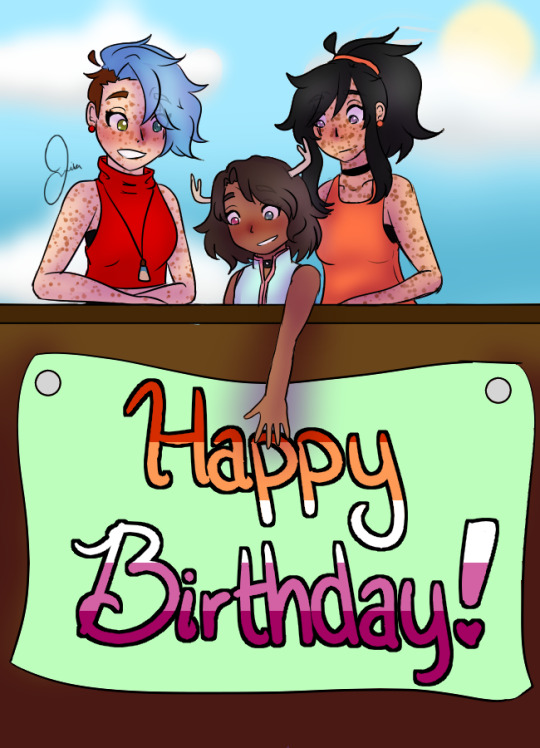
Happy birthday to one of my best friends / roommate Tori! <3
Show her some love for her birthday on her socials!:
Instagram || ArtFight (she’s on Sugar like me!) || deviantArt
And for those who don’t know these cuties, from left to right:
Jiku (my online persona)
Dublin (Tori’s reindeer faunus baby)
Sora (Dublin’s girlfriend)
0 notes